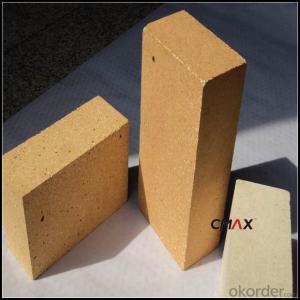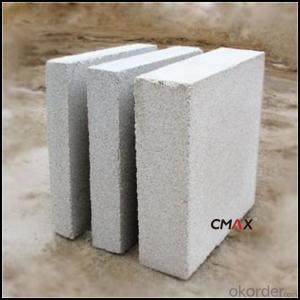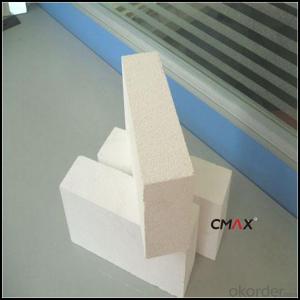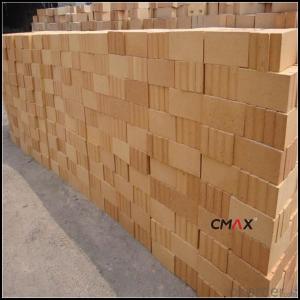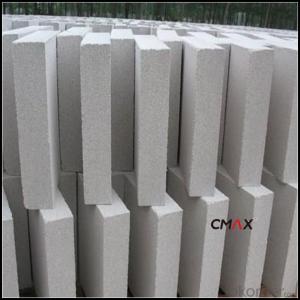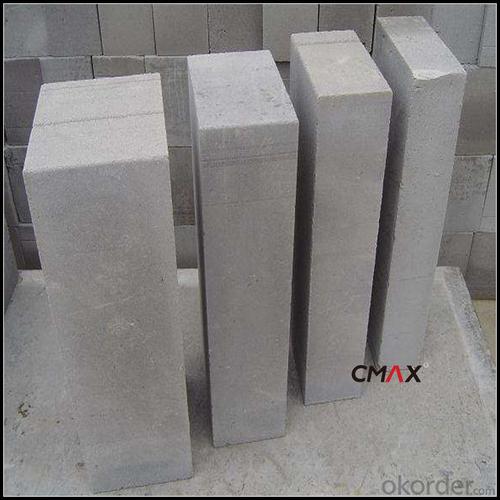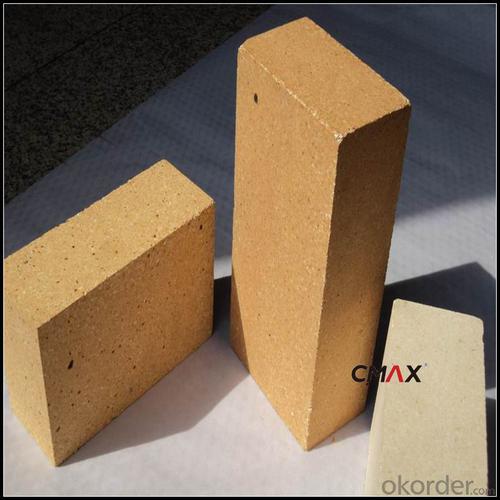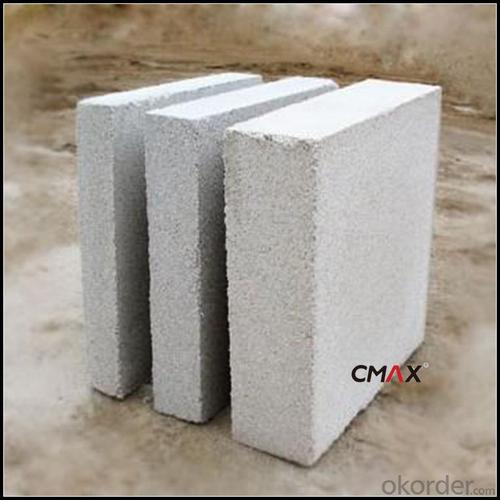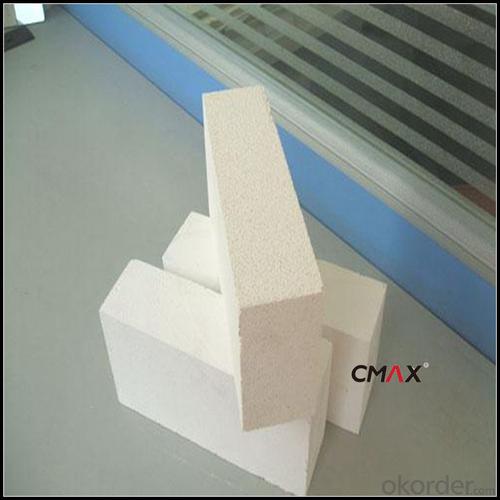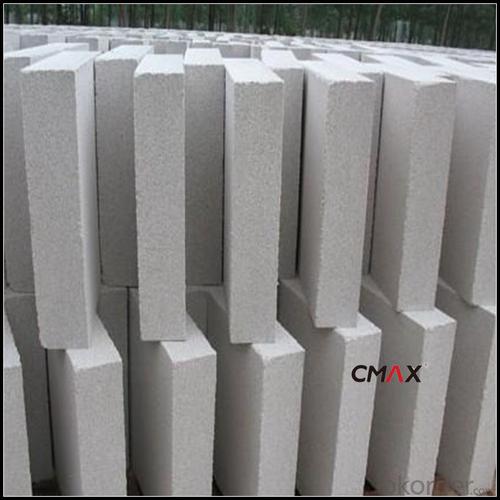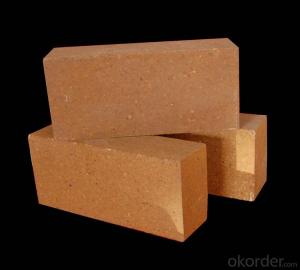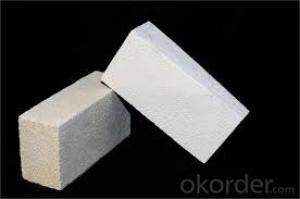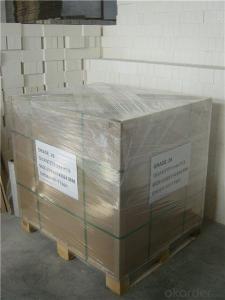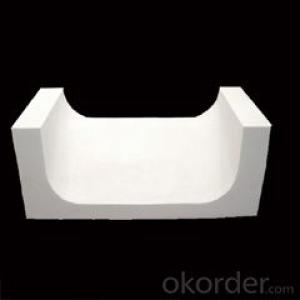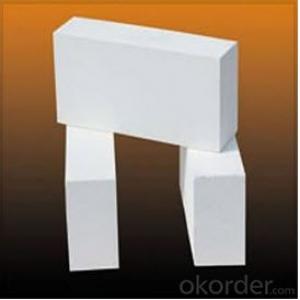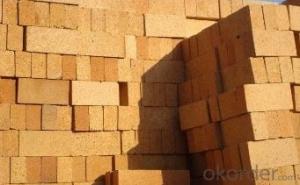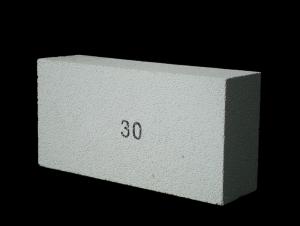Insulating Fire Brick - Refractory Heat Insulation Brick
- Loading Port:
- China main port
- Payment Terms:
- TT OR LC
- Min Order Qty:
- 2 m.t
- Supply Capability:
- 2000 m.t/month
OKorder Service Pledge
OKorder Financial Service
You Might Also Like
Insulating Brick
CMAX insulating firebricks are classified under temperature between 1300℃ to 1700℃, manufactured from high purity alumina clay.
1.High Alumina Brick used for cement kiln, otary kiln and other high temperature kiln.
2,Magnesia Carbon Brick used for converter furnace,ladle and electric furnace.
3,Insulating Bricks used for insualting layer for high temperature furnce
4,Nozzle Bricks slide gate brick that can be used for tundish and ladle
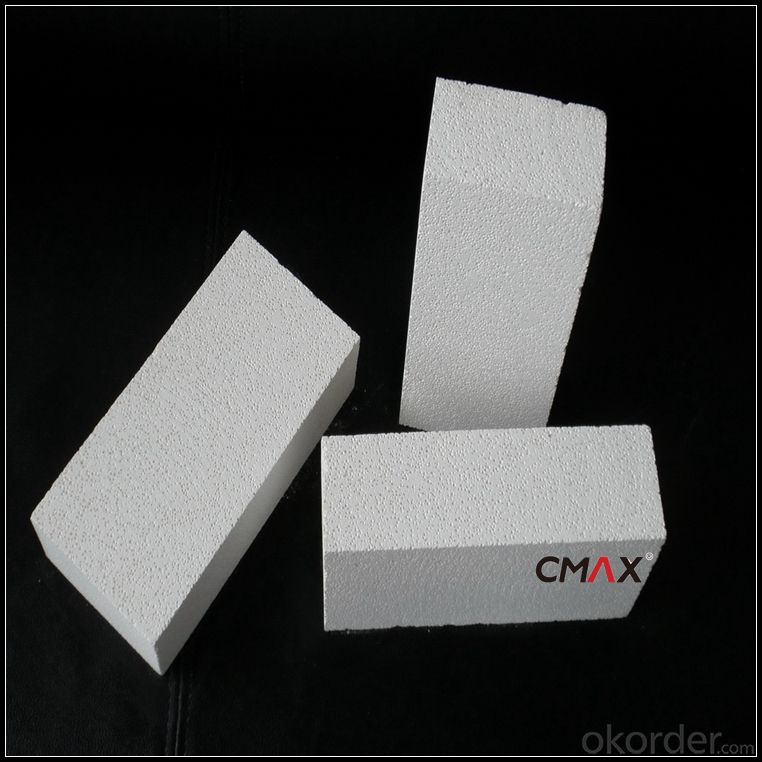
Insulating Brick Features
1.Low thermal conductivity, low thermal capacity, low impurity content
2.High strength
3.Good thermal shock resistance, Corrosion atmosphere resistance
4.High dimensional accuracy
5.Low reheat shrinkage
Insulating Brick Application
glass industries iron & steel industries
ceramics industries non-ferrous metals industries
electrolytic Aluminum industries power generation industries
Heat surface fireproof lining other fire-proof back lining
Process Of Refractory Heat Insulation BrickRaw material to factory→checkout→burdening→stirring→mixing→taking out the raw material
→transfer→enter into mould→press machine extrusion→going out the mould→stoving→going into the furnace
→firing→stopping burn→cooling→open the furnace door→going out the furnace→checkout
→packing→qualified product→putting in storage→sale
Insulating Brick Data Sheet
Classification Temperature (℉/℃) | 3000/1650 |
Bulk Density (g/cm3 ) | ≤1.0 |
Thermal Conductivity | |
800℃, W/m.K | ≤0.39 |
1000℃, W/m.K | ≤0.43 |
1200℃, W/m.K | ≤0.48 |
Reheating Linear Change (%) | 1550℃×12h |
≤0.9 | |
Chemical Composition (%) | |
Al2O3 | ≥75 |
Fe2O3 | ≤0.5 |
Packaging & Shipping
Packaging Details:Be packed in fumigated wooden pallets
Delivery Detail: 30 days after order

Our Services
Optimum solution and product supply of refractories for high temperature industries, such as iron steel, non-ferrous, petrochemical and building materials.
Engineering design, contract and consult for refractories, and civil architecture design.
Research, development, manufacture and sale of superhard materials.
R&D, manufacture and sale of special packing materials for export.
Inspection, supervision and arbitration of refractories.
Consultation and services in refractories information.
Training and cultivation of high-level talents in refractories profession
Sales Network

Company Information
CNBM (China National Building Material) Group is the largest comprehensive building materials group in China that in integrate scientific research, manufacturing and logistics into one entity. The largest building materials and equipment specialists in China. Upon State Council approval, today CNBM owned more than 300 subordinate manufacturing factories and servicing companies. There are 6 fully owned public listed companies and 11 partially owned with substantial shares public listed companies. In many of these fields, CNBM is playing the leading role in the building industry in the country.
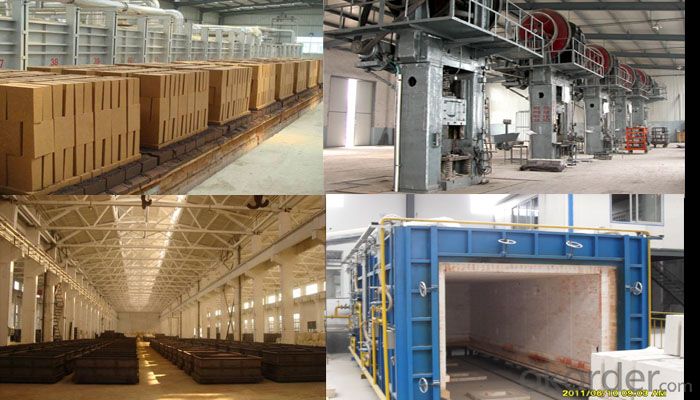
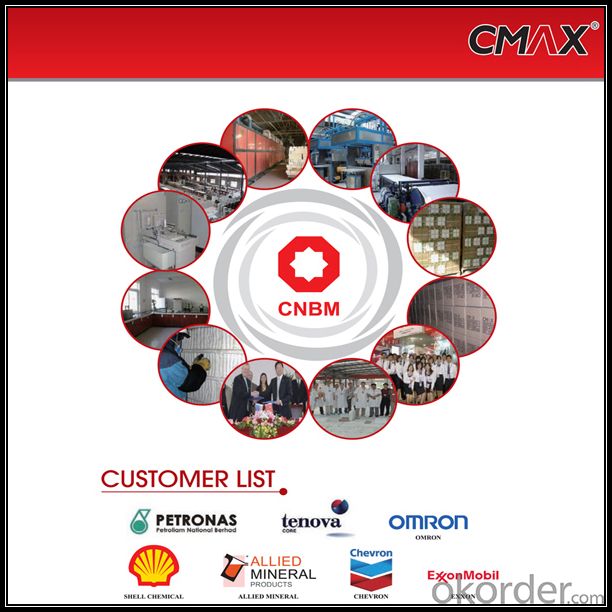
FAQ
1. Which products do you have?
We have all kinds of refractory brick, castable, mortar, cement, ceramic fiber products, etc.
Or you could browse our products to choose what you need.
2. Can you give me a brief introduction of the application of your products?
We are mainly specializing in the refractory materials in iron and steel, cement, glass, ceramics, petrochemical, electric power Industry, etc.
3. If I need your offer, what information do you need?
In order to choose suitable products, it will be appreciated to provide us the information, such us specification, technical data, order quantity, products application etc. If any question, please contact us freely.
- Q: Masonry method for boiler refractory brick
- Furnace wall gas tightness requirements, gray seam fullness requirements: red brick is not less than 85%; refractory brick not less than 90%. When the red brick is built, the method of squeezing is adopted, and the construction of the refractory brick is constructed by scraping.
- Q: Can insulating fire bricks be used for insulation in solar thermal systems?
- Indeed, insulation in solar thermal systems can be achieved by utilizing insulating fire bricks. These bricks have been specifically engineered to possess a low thermal conductivity, enabling them to effectively capture and retain heat. As a result, they prove to be suitable for insulating various components of a solar thermal system, including the solar collector and storage tank, thereby minimizing heat dissipation and enhancing the system's overall efficiency. Furthermore, insulating fire bricks exhibit remarkable resistance to high temperatures, a critical characteristic in solar thermal systems where extreme temperatures can be encountered. In summary, the utilization of insulating fire bricks as insulation in solar thermal systems serves to enhance performance and diminish energy loss.
- Q: Can insulating fire bricks be used for insulation in cement kilns?
- Yes, insulating fire bricks can be used for insulation in cement kilns. Insulating fire bricks have excellent thermal insulation properties and can withstand high temperatures, making them suitable for insulating cement kilns and reducing heat loss.
- Q: Are insulating fire bricks suitable for use in boilers?
- Boilers can indeed utilize insulating fire bricks. With their ability to withstand high temperatures, insulating fire bricks prove themselves as a viable option for a range of applications, including boilers. These bricks are crafted from lightweight materials like ceramic fibers or vermiculite, imparting exceptional thermal insulation properties. Consequently, they proficiently trap heat within the boiler, curbing heat loss and enhancing energy efficiency. Furthermore, insulating fire bricks exhibit resilience against thermal shock, chemical attack, and corrosion, ensuring their endurance and longevity in boiler settings. In summary, incorporating insulating fire bricks in boilers can optimize performance, decrease energy consumption, and elevate the overall efficiency of the heating system.
- Q: Do insulating fire bricks have a low thermal expansion rate?
- Yes, insulating fire bricks generally have a low thermal expansion rate. These bricks are designed to withstand high temperatures and thermal shocks, and one of their key properties is their ability to maintain their shape and dimensions under extreme heat conditions. Insulating fire bricks are made from materials that have a low coefficient of thermal expansion, meaning they expand and contract minimally when exposed to changes in temperature. This low thermal expansion rate ensures that the bricks remain stable and do not crack or break due to thermal stress. Additionally, the low thermal expansion rate of insulating fire bricks allows for better insulation performance, as it minimizes the gaps that can form between the bricks when they expand and contract, reducing heat loss and increasing energy efficiency.
- Q: Can insulating fire bricks be used for flooring insulation?
- No, insulating fire bricks are not suitable for flooring insulation as they are primarily designed for use in high-temperature applications like fireplaces, furnaces, and kilns. Flooring insulation requires materials that can withstand foot traffic, moisture, and other stresses that insulating fire bricks may not be able to handle effectively.
- Q: Are insulating fire bricks suitable for use in residential fireplaces?
- Depending on the homeowner's specific requirements and preferences, insulating fire bricks can be a suitable option for residential fireplaces. These bricks are designed to have low thermal conductivity, which effectively retains heat and prevents its escape from the fireplace. Consequently, less heat is lost through the bricks, resulting in more efficient and effective heating of the room. Moreover, insulating fire bricks are lightweight and easy to handle, making them a convenient choice for homeowners who wish to install or replace bricks themselves. Additionally, they are durable and can withstand high temperatures, ensuring their longevity when exposed to the intense heat produced by the fire. Nevertheless, it is crucial to recognize that insulating fire bricks may not be ideal for everyone. Traditional fire bricks, being denser with higher thermal mass, can absorb and radiate heat for a longer duration. This attribute creates a more consistent and long-lasting heat output, which may be preferred by some homeowners. Ultimately, the decision to use insulating fire bricks in a residential fireplace should be based on the specific needs and preferences of the homeowner. Seeking guidance from a professional fireplace installer or a reputable supplier can help ensure that the chosen bricks are suitable for the intended use.
- Q: Can insulating fire bricks be used in cement kilns?
- Yes, insulating fire bricks can be used in cement kilns. Insulating fire bricks are designed to have low thermal conductivity, which makes them ideal for insulating high-temperature environments such as cement kilns. These bricks can help to reduce heat loss and improve energy efficiency in the kiln. Additionally, their lightweight nature makes them easier to handle and install in the kiln. However, it is important to ensure that the insulating fire bricks selected are compatible with the specific operating conditions and requirements of the cement kiln to ensure optimal performance and longevity.
- Q: Can insulating fire bricks be used in biomass power plants?
- Insulating fire bricks possess the capability to be utilized within biomass power plants. Specifically designed to endure extreme temperatures and offer insulation, these fire bricks are well-suited for an array of applications in high-temperature settings, including biomass power plants. These power plants generate electricity by incinerating biomass materials such as wood chips, agricultural waste, and other organic substances. The usage of insulating fire bricks can span across multiple areas within a biomass power plant. Primarily, they can be employed to line the combustion chamber where the biomass is burned, releasing heat. The insulating properties of these bricks aid in containing the heat within the combustion chamber, thereby enhancing the efficiency of the biomass combustion process. Furthermore, insulating fire bricks serve a purpose in the construction of the plant's boiler, responsible for converting the heat produced by the biomass incineration into steam. The bricks can be utilized to line the walls and roof of the boiler, delivering thermal insulation and preventing heat loss. This insulation serves to maintain high temperatures inside the boiler, which is vital for steam generation and subsequent power production. Moreover, the construction of the chimney or flue system of biomass power plants can also incorporate insulating fire bricks. These bricks can be utilized to line the interior of the chimney, ensuring that the high temperatures and corrosive gases resulting from biomass combustion are safely contained and directed out of the plant. In summary, insulating fire bricks are an exceptional choice for biomass power plants due to their ability to withstand high temperatures and provide thermal insulation. Their utilization in the combustion chamber, boiler, and chimney systems contributes to the improvement of efficiency and safety in biomass power generation.
- Q: Are insulating fire bricks porous?
- Yes, insulating fire bricks are porous. Porosity is a characteristic of insulating fire bricks that allows them to have low thermal conductivity. These bricks are made from ceramic materials and contain a high percentage of tiny air pockets or voids, which trap and slow down the transfer of heat. This porosity also makes the bricks lightweight and resistant to thermal shock. The ability of the insulating fire bricks to retain heat and provide effective insulation is directly linked to their porous structure.
Send your message to us
Insulating Fire Brick - Refractory Heat Insulation Brick
- Loading Port:
- China main port
- Payment Terms:
- TT OR LC
- Min Order Qty:
- 2 m.t
- Supply Capability:
- 2000 m.t/month
OKorder Service Pledge
OKorder Financial Service
Similar products
Hot products
Hot Searches
Related keywords

